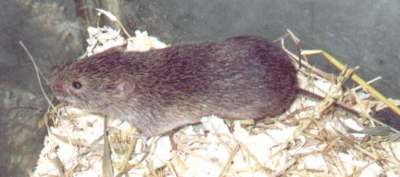Pests
Microtus rossiaemeridionalis (Ognev, 1924) - Russian Common Vole (Russian Meadow Mouse)
Systematic position.
The class Mammalia, order Rodentia, family Cricetidae, subfamily Microtinae, genus Microtus, subgenus Microtus (Schrank, 1798) - grey voles. The species is a sibling species to Common Vole (Microtus arvalis).Biological group.
Rodent pests.Morphology and biology.
External characters usually used in systematics do not differ from those of Common Vole (Microtus arvalis). But individuals of both species collected from the same habitat differ in size. Body length of the Russian Common Vole, is up to 125 mm, tail length, up to 48 mm (about 34 % of body length on the average). Usually 6 calluses on back foot. Main diagnostic feature is number of diploid chromosomes (2n=54). The two species also differ by spermatozoa's head shape, and by karyotype; reproductive isolation is also observed. The two species live in the same habitat, forming mixed settlements. Mound distribution, digging, feeding and other aspects of life activities and behavior between the two species have no essential differences.Distribution.
Since the species was defined rather recently, further research is necessary to clarify species distribution. Known data demonstrates that a large part of the species geographic area coincides with the geographic area of the Common Vole, but is found in the central part of distribution area. The Russian Common Vole occurs further north, (to Finland), and does not go as far in the south (only rarely found in Transcaucasia) and to the southeast (known in the Kustanai Region only in Kazakhstan). However, dominates plains of Eastern Europe; it is eurysynusic in Ukraine (in 14 regions), in eastern part predominantly. The species is found in the Leningrad and Moscow Regions. It is the main species in the Lower and Middle Volga Basin Regions. The western border of the geographic area occurs from the Baltic countries through Byelorussia, Moldova and Romania. In the south, settlements were found in the Balkan States (southern Serbia, most parts of Macedonia). Irkutsk Region is the most eastern point of area.Ecology and economic significance.
Distinguishing between the Russian Common Vole and Common Vole is difficult due to the lack of field observations and experiments. Generally, information on the ecology and economic significance of the Common Vole, applies also to the Russian Common Vole. Further research is necessary to update this information with reference to each species. Control measures are the same as in the case of Microtus arvalis. Related References:Gromov I.M., Erbaeva M.A. 1995. Mammals of Russia and adjacent territories. Leporids and rodents. Keys to Russian Fauna published by Zoological Institute of Russian Academy of Science (RAN). St. Petersburg: ZIN RAN. N.167: 522. (In Russian)
Malygin V.M. 1983. Systematics of Common Voles. Moscow: Nauka. 206 pp. (In Russian)
Sokolov V.E., Bashenina N.V., eds. 1994. Common Voles-sibling species. Moscow: Nauka. 432 pp. (In Russian)


